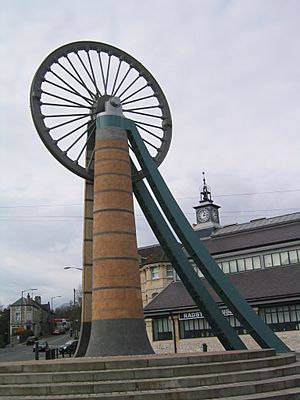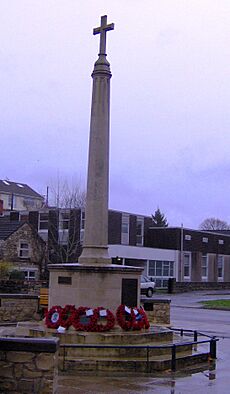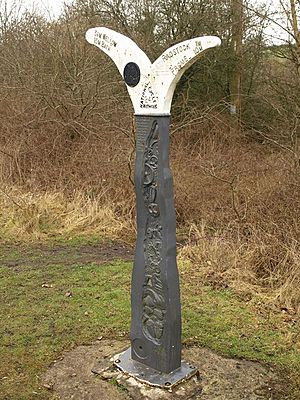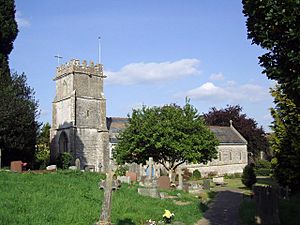Radstock facts for kids
Quick facts for kids Radstock |
|
|---|---|
 The old winding wheel on a headframe, now in the centre of Radstock, in front of the Radstock Museum |
|
| Population | 9,419 (built-up area, 2011) |
| OS grid reference | ST689550 |
| Civil parish |
|
| Unitary authority | |
| Ceremonial county | |
| Region | |
| Country | England |
| Sovereign state | United Kingdom |
| Post town | RADSTOCK |
| Postcode district | BA3 |
| Dialling code | 01761 |
| Police | Avon and Somerset |
| Fire | Avon |
| Ambulance | Great Western |
| EU Parliament | South West England |
| UK Parliament |
|
Radstock is a town in Somerset, England. It's located on the northern side of the Mendip Hills, about 9 kilometers (5.6 miles) southwest of Bath. The town is part of the Bath and North East Somerset area. In 2011, the Radstock area had a population of 9,419 people.
People have lived in Radstock since the Iron Age. The town became more important after the Fosse Way, a Roman road, was built. Radstock really grew after coal was found there in 1763. Many mines opened in the 1800s. The Waldegrave family, who owned the land, also owned several mines.
Today, Radstock is home to the Radstock Museum. This museum shows what life was like in north-east Somerset since the 1800s. Many exhibits are about the local Somerset coalfield, which is no longer used. Radstock also has Writhlington School, which is famous for its amazing Orchid collection. The town has many other buildings for education, religion, and culture, plus sports clubs.
Contents
- Radstock's Past: A Look at History
- How Radstock is Governed
- Radstock's Location and Landscape
- Population of Radstock
- Getting Around Radstock: Transport
- Memorial Gardens: A Place to Remember
- Radstock Museum: Exploring the Past
- Learning in Radstock: Education
- Fun and Games: Sport and Leisure
- News and Media
- Places of Worship
- Famous People from Radstock
- See also
Radstock's Past: A Look at History
Radstock has a long history, going back to the Iron Age. Its importance grew when the Fosse Way, a major Roman road, was built. This road is now part of the A367 in Radstock. In the Domesday Book of 1086, the town was called Stoche. This name meant 'the stockade by the Roman road'. The 'rad' part of Radstock is thought to come from the reddish soil found in the area.
How Railways Shaped Radstock
The Great Western Railway and the Somerset and Dorset Railway built train stations and large areas for sorting trains (marshalling yards) in Radstock. The town became a key spot for railways. It had big coal depots, wash houses, workshops, and a gas works. A train line was built from Radstock to Frome to carry coal. This line was later connected to the Bristol and North Somerset Line, linking Radstock to the Great Western Railway.
Sadly, a serious train crash happened near Radstock on August 7, 1876. Two trains crashed on a single track, and 15 passengers died.
The last passenger trains in Radstock stopped running in 1966. The last coal mines closed in 1973. Now, industries like printing and packaging offer jobs. Radstock has also become a "commuter town" for people who work in nearby Bath and Bristol. This means more traffic during busy times.
The Story of Coal Mining in Radstock
Coal was found in Radstock in 1763, and mining started. By 1896, the Waldegrave family, who had been important landowners since the English Civil War, owned many of the pits. Over the years, many mines opened, including Ludlows, Middle Pit, and Wellsway.
The spoil heap (a pile of waste rock) from Writhlington colliery is now a special protected area called the Writhlington SSSI. This site has 3,000 tons of old rock from which over 1,400 insect fossils have been found! These include some of the world's earliest known Damselfly fossils.
Mining coal in Radstock was tough because the rock layers were complex and the coal seams were narrow. There were even underground explosions caused by coal dust. Coal production grew in the 1800s, reaching its highest point around 1901. At that time, there were 79 different mines producing 1.25 million tons of coal each year. However, due to the difficult geology and fewer workers, the number of mines dropped. The last two mines, Kilmersdon and Writhlington, closed in September 1973.
How Radstock is Governed
In 2011, Radstock got its own town council. Before that, it was part of a larger area called Norton Radstock.
Today, Radstock is managed by the Bath and North East Somerset authority. This is a type of local government that handles many services for the area. The Radstock Town Council also helps run things in the town.
The area is part of the Frome and East Somerset area for the UK Parliament. This means people in Radstock vote for a Member of Parliament (MP) to represent them in the national government.
Radstock's Location and Landscape
Radstock is located in the Mendip Hills. The ground here has layers of coal and sandstone. The Mendip Hills were pushed up by powerful forces long ago, causing the coal layers to break along cracks called faults.
The town sits on the Wellow Brook, a small river that eventually joins the River Avon. The valley floor has soft soil, and the hillsides are made of different types of Limestone from the Jurassic period. Below all of this are the coal-bearing rocks.
The landscape around Radstock still shows signs of its coal mining past. The old railway lines and mining areas have created special natural habitats for plants and animals.
Radstock's Climate
Radstock has a mild and wet climate, typical for South West England. The average temperature is about 10 °C (50 °F). January is the coldest month, and July and August are the warmest.
Radstock gets about 1,600 hours of sunshine each year. It rains about 800–900 mm (31–35 in) annually, often from Atlantic storms or summer showers. Snowfall is typical for about 8–15 days a year. The wind usually blows from the southwest.
Population of Radstock
In 2011, the Radstock parish had a population of 5,620 people. The wider built-up area, which includes the Westfield area, had a population of 9,419 people at that time.
Getting Around Radstock: Transport
Radstock was once the end point for a branch of the Somerset Coal Canal. This canal was later turned into a tramway and then became part of the Somerset and Dorset Joint Railway. Radstock became a hub for railways, with large coal depots and workshops.
Today, an old railway line is now National Cycle Route 24, also known as the Colliers' Way. This cycle path goes past many places linked to the coal mining history. It runs from Dundas Aqueduct to Frome through Radstock.
Radstock used to have two train stations, but they both closed. The last one closed in 1966. Today, the closest train station is Bath Spa, which you can easily reach by bus.
Radstock is located on the A367 road, which connects Bath and Shepton Mallet. It's also on the A362 road, which goes between Farrington Gurney and Frome.
Memorial Gardens: A Place to Remember
After the railways closed, the land in the center of Radstock was empty for many years. There was an old mine wheel on the site. People wanted to create a memorial park there to remember the town's mining history and to give the war memorial a new home.
In 2005, the Memorial Gardens were built. They include a new artistic base for the old mine wheel. The town's war memorial was also moved here. The gardens have a natural look with many colorful plants that bloom throughout the year.
Radstock Museum: Exploring the Past
The Radstock Museum is located in the town's old market hall. The museum has many exhibits that show what life was like in north-east Somerset since the 1800s.
The museum first opened in 1989 in barns in Haydon. It moved to its current home in the restored Victorian Market Hall in 1999. This building is a Grade II listed building, meaning it's historically important. Many exhibits are about the local Somerset coalfield and geology. Other displays cover local history, including schools, shops, a forge, and farming. You can also see items from the Somerset Coal Canal and the old railways.
Learning in Radstock: Education
Radstock has several primary schools for children up to age 11, including St Mary's C of E Primary School and Trinity Primary School. For students with special learning needs, there's Fosseway School in nearby Westfield.
Writhlington School in Radstock is a secondary school for students aged 11–18. It's known for its amazing orchid project, which has one of the biggest collections of orchids outside Kew Gardens. The school has won many awards, including a gold medal at the 2009 Chelsea Flower Show.
The town is also served by the Somer Valley site of Bath College, which offers further education courses in Westfield.
Fun and Games: Sport and Leisure
Radstock has a local football club called Radstock Town F.C.. They play their games at The Southfields Recreation Ground.
News and Media
Radstock has local newspapers like the Midsomer Norton, Radstock & District Journal and the Somerset Guardian. The Mendip Times magazine also features local stories.
For TV and radio, Radstock gets news from BBC West and ITV West Country. Local radio stations include BBC Radio Somerset, Heart West, Greatest Hits Radio South West, and Somer Valley FM.
Places of Worship
Radstock has four churches that work together as "Churches together in Radstock." They often hold services to promote unity.
- The Anglican church of St Nicholas has a tower from the 1400s. The rest of the church was rebuilt in 1879. It is a Grade II listed building.
- Radstock Methodist Church started in 1842, and its current building opened in 1902.
- Radstock Baptist Church on Wells Hill was founded in 1844.
- St Hugh's church, which was a Catholic Church, closed in 2018 and was turned into homes.
- Radstock also has a Jehovah's Witness Kingdom Hall.
Famous People from Radstock
- L. J. F. Brimble (1904–65), a botanist and editor of Nature magazine.
- Frank Coombs (1906–1941), an English painter and architect.
- Alick Grant (1916–2008), a footballer who played for several teams.
- Bill Hyman (1875–1959), a cricketer for Somerset County.
- Ernest Hyman (1904–1927), a footballer for Yeovil Town.
- Frank Pratten (1886–1941), who founded a company that made prefabricated buildings.
See also
In Spanish: Radstock para niños






